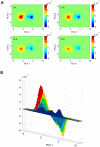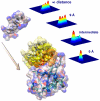In silico elucidation of the recognition dynamics of ubiquitin
- PMID: 21533067
- PMCID: PMC3080845
- DOI: 10.1371/journal.pcbi.1002035
In silico elucidation of the recognition dynamics of ubiquitin
Abstract
Elucidation of the mechanism of biomacromolecular recognition events has been a topic of intense interest over the past century. The inherent dynamic nature of both protein and ligand molecules along with the continuous reshaping of the energy landscape during the binding process renders it difficult to characterize this process at atomic detail. Here, we investigate the recognition dynamics of ubiquitin via microsecond all-atom molecular dynamics simulation providing both thermodynamic and kinetic information. The high-level of consistency found with respect to experimental NMR data lends support to the accuracy of the in silico representation of the conformational substates and their interconversions of free ubiquitin. Using an energy-based reweighting approach, the statistical distribution of conformational states of ubiquitin is monitored as a function of the distance between ubiquitin and its binding partner Hrs-UIM. It is found that extensive and dense sampling of conformational space afforded by the µs MD trajectory is essential for the elucidation of the binding mechanism as is Boltzmann sampling, overcoming inherent limitations of sparsely sampled empirical ensembles. The results reveal a population redistribution mechanism that takes effect when the ligand is at intermediate range of 1-2 nm from ubiquitin. This mechanism, which may be depicted as a superposition of the conformational selection and induced fit mechanisms, also applies to other binding partners of ubiquitin, such as the GGA3 GAT domain.
Conflict of interest statement
The authors have declared that no competing interests exist.
Figures






Similar articles
-
A correspondence between solution-state dynamics of an individual protein and the sequence and conformational diversity of its family.PLoS Comput Biol. 2009 May;5(5):e1000393. doi: 10.1371/journal.pcbi.1000393. Epub 2009 May 29. PLoS Comput Biol. 2009. PMID: 19478996 Free PMC article.
-
Slow conformational exchange and overall rocking motion in ubiquitin protein crystals.Nat Commun. 2017 Jul 27;8(1):145. doi: 10.1038/s41467-017-00165-8. Nat Commun. 2017. PMID: 28747759 Free PMC article.
-
Conformational and dynamic changes at the interface contribute to ligand binding by ubiquitin.Biochemistry. 2012 Oct 16;51(41):8111-24. doi: 10.1021/bi3004268. Epub 2012 Oct 4. Biochemistry. 2012. PMID: 23035694
-
Conformational dynamics and thermodynamics of protein-ligand binding studied by NMR relaxation.Biochem Soc Trans. 2012 Apr;40(2):419-23. doi: 10.1042/BST20110750. Biochem Soc Trans. 2012. PMID: 22435823 Review.
-
Conformational Sub-states and Populations in Enzyme Catalysis.Methods Enzymol. 2016;578:273-97. doi: 10.1016/bs.mie.2016.05.023. Epub 2016 Jul 9. Methods Enzymol. 2016. PMID: 27497171 Free PMC article. Review.
Cited by
-
Bioinformatics and variability in drug response: a protein structural perspective.J R Soc Interface. 2012 Jul 7;9(72):1409-37. doi: 10.1098/rsif.2011.0843. Epub 2012 May 2. J R Soc Interface. 2012. PMID: 22552919 Free PMC article. Review.
-
Binding Mechanisms of Intrinsically Disordered Proteins: Theory, Simulation, and Experiment.Front Mol Biosci. 2016 Sep 9;3:52. doi: 10.3389/fmolb.2016.00052. eCollection 2016. Front Mol Biosci. 2016. PMID: 27668217 Free PMC article. Review.
-
Nanosecond time scale motions in proteins revealed by high-resolution NMR relaxometry.J Am Chem Soc. 2013 Dec 11;135(49):18665-72. doi: 10.1021/ja409820g. Epub 2013 Nov 26. J Am Chem Soc. 2013. PMID: 24228712 Free PMC article.
-
Increased usability, algorithmic improvements and incorporation of data mining for structure calculation of proteins with REDCRAFT software package.BMC Bioinformatics. 2020 Dec 3;21(Suppl 9):204. doi: 10.1186/s12859-020-3522-x. BMC Bioinformatics. 2020. PMID: 33272215 Free PMC article.
-
Atomistic Insights into the Functional Instability of the Second Helix of Fatty Acid Binding Protein.Biophys J. 2019 Jul 23;117(2):239-246. doi: 10.1016/j.bpj.2019.06.012. Epub 2019 Jun 20. Biophys J. 2019. PMID: 31301805 Free PMC article.
References
-
- Fischer E. Einfluss der configuration auf die Wirkung der enzyme. Ber Dt Chem Ges. 1894;27:2985–2993.
Publication types
MeSH terms
Substances
LinkOut - more resources
Full Text Sources
Other Literature Sources
Miscellaneous

